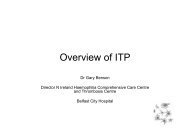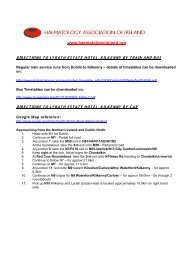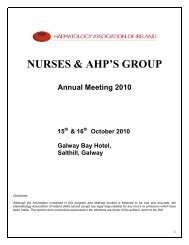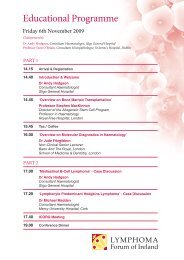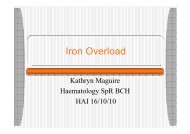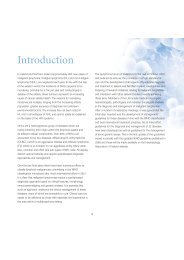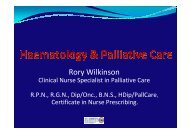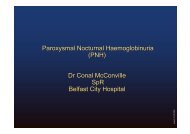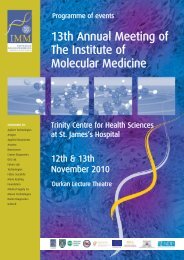Guidelines on Diagnosis and Treatment of Malignant Lymphomas
Guidelines on Diagnosis and Treatment of Malignant Lymphomas
Guidelines on Diagnosis and Treatment of Malignant Lymphomas
Create successful ePaper yourself
Turn your PDF publications into a flip-book with our unique Google optimized e-Paper software.
Hodgkin Lymphoma (HL)<br />
Definiti<strong>on</strong> <strong>and</strong> Incidence<br />
The crude incidence <strong>of</strong> Hodgkin lymphoma in the European<br />
Uni<strong>on</strong> is 2.2/100,000/year <strong>and</strong> mortality is 0.7/100,000/year. HLs<br />
account for approximately 15% <strong>of</strong> lymphomas <strong>and</strong>, in c<strong>on</strong>trast to<br />
n<strong>on</strong>-Hodgkin lymphomas, their absolute incidence has not<br />
increased in recent decades.<br />
The goal <strong>of</strong> HL therapy is the “least complicated cure” with a<br />
pers<strong>on</strong>alised approach. The associated risks <strong>of</strong> treatment,<br />
including sterility <strong>and</strong> the risk <strong>of</strong> sec<strong>on</strong>d malignancy, have<br />
influenced the current management <strong>of</strong> early stage n<strong>on</strong>-bulky HL<br />
towards brief chemotherapy followed by involved field irradiati<strong>on</strong><br />
with more chemotherapy <strong>and</strong> less irradiati<strong>on</strong> in those with higherstaged<br />
illness. ABVD remains the internati<strong>on</strong>al st<strong>and</strong>ard cytotoxic<br />
chemotherapy. The role <strong>of</strong> BEACOPP in advanced disease is<br />
under investigati<strong>on</strong> with a view to optimising fr<strong>on</strong>tline treatment<br />
to avoid the need for salvage therapy <strong>and</strong> transplant. F 18 DG<br />
PET/CT scan is a now well established in staging, resp<strong>on</strong>se<br />
assessment <strong>and</strong> evaluati<strong>on</strong> <strong>of</strong> residual masses.<br />
ICD – O Codes:<br />
Nodular lymphocyte predominant<br />
Hodgkin lymphoma NLPHL 9659/3<br />
Classical Hodgkin lymphoma CHL 9650/3<br />
■ Nodular sclerosis classical<br />
Hodgkin lymphoma NSHL 9663/3<br />
■ Mixed cellularity classical<br />
Hodgkin lymphoma MCHL 9652/3<br />
■ Lymphocyte-rich classical<br />
Hodgkin lymphoma LRCHL 9651/3<br />
■ Lymphocyte-depleted classical<br />
Hodgkin lymphoma LDHL 9653/3<br />
Clinical Presentati<strong>on</strong>:<br />
Classical Hodgkin lymphoma (CHL) accounts for 95% <strong>of</strong> HL<br />
with a bimodal age curve showing a peak at 15-35 years <strong>and</strong> a<br />
sec<strong>on</strong>d peak in later life. Patients with a history <strong>of</strong> infectious<br />
m<strong>on</strong><strong>on</strong>ucleosis have a higher incidence <strong>of</strong> HL <strong>and</strong> both familial<br />
<strong>and</strong> geographic clustering has been described. Patients usually<br />
present with peripheral lymphadenopathy at <strong>on</strong>e or two sites.<br />
Mediastinal involvement is most frequently seen with Nodular<br />
Sclerosis Hodgkin lymphoma (NSHL) while abdominal <strong>and</strong><br />
splenic involvement is more comm<strong>on</strong> with Mixed Cellularity<br />
Hodgkin lymphoma (MCHL). About 40% will have systemic<br />
symptoms c<strong>on</strong>sisting <strong>of</strong> fever, drenching night sweats <strong>and</strong><br />
significant weight loss.<br />
Patients with Nodular Lymphocyte Predominant Hodgkin<br />
lymphoma (NLPHL) usually present with localized peripheral<br />
lymphadenopathy (stage I or II). Between 5% <strong>and</strong> 20% <strong>of</strong><br />
patients present with advanced stage disease. NLPHL is an<br />
indolent disease <strong>and</strong> previous lymph node biopsies may have<br />
been interpreted as representing a reactive process. Relapses are<br />
frequent but the disease usually remains resp<strong>on</strong>sive to treatment<br />
<strong>and</strong> is thus rarely fatal. Transformati<strong>on</strong> to diffuse large B-cell<br />
lymphoma (DLBCL) may rarely occur.<br />
Pathology <strong>and</strong> Genetics<br />
Pathologic diagnosis should be made according to the<br />
WHO classificati<strong>on</strong> as described above.<br />
59



